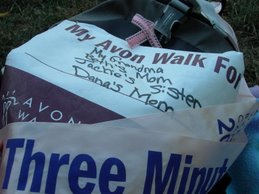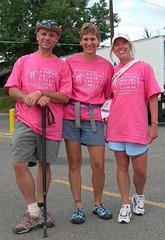
My friend Dana and I are walking to Chiamayo on Good Friday as part of the pilgrimage. We are planning to walk about 20 miles (mapquest says it is 23 miles) starting at the Camel Rock Casino.
Here is an article by a reporter about his experience walking to Chimayo

I did a section of the walk to Chimayo in 2002. It was an experience I will never forget, and is part of my motivation for doing the walk in Denver. I didn't know it was a big deal to walk a long distance. I thought walking - just putting one foot in front of the other - should be no problem for someone in good health. The 20 miles I walked were tough, and it took me about a week to recover. I hadn't trained at all. Along the walk I saw people who were very sick and elderly successfully making the walk. It is a spiritual and cultural experience that I am looking forward to this year.
The Archdiocese of Santa Fe tells the story of the Santuario de Chimayo.
El Santuario has been called the "Lourdes of America". No one seems to know exactly how this came about. However, there are testimonies that the extraordinary has occurred. Fr. Sebastian Alvarez in his letter to the Episcopal See of Durango, dated November l6, l8l3, expressed his feelings of the people coming from afar to seek cures for their ailments and the spreading of the fame of their cures, induced many more faithful to come in pilgrimage. He did not mention any specific fact, but something was there. El Santuario has been a place of worship from the beginning - a place to pray, to thank, to ask, to meditate and to experience peace of mind as well as of body.
In time, the mass media paid attention to the little Shrine in the Sangre de Cristo Mountains. Newspapers from Chicago, Denver, New York and Los Angeles, Time and Newsweek magazines have all taken it upon themselves to inform the public about the Shrine. This has resulted in a considerable flow of mail requesting information about the Shrine. People come to the Santuario in the thousands, close to 300,000 a year. They come to worship the Almighty, to ask for peace in the world and in their hearts, to fulfill a promise, to feel the healing touch of God.
El Santuario (The Shrine) was built between l8l4 and l8l6. The "miraculous" crucifix of Our Lord of Esquipulas was found around l8l0. There is no written testimony concerning the apparition of Our Lord in the Chimayo area. What we have is tradition passed from one generation to another by the people of El Potrero. Here is one account of a "true" story as told by the storyteller.
One tradition recalls that during Holy Week on the night of Good Friday, Don Bernardo Abeyta, who was a member in good standing of the Hermandad de Nuestro Padre Jes6s el Nazareno (Penitentes) was performing the customary penances of the Society around the hills of El Potrero. Suddenly he saw a light springing from one of the slopes of the hills near the Santa Cruz River. Don Bernardo went to the spot and noticed that the shining light was coming from the ground. He started to dig with his bare hands, and there he found a Crucifix. He left it there and called the neighbors to come and venerate the precious finding. A group of men was sent to notify the priest, Fr. Sebastian Alvarez at Santa Cruz.

Upon hearing the extraordinary news, the priest and people set out for Chimayo. When they arrived at the place where the Crucifix was, Fr. Sebastian picked it up and carried it in a joyful procession back to the church. Once in the church, the Crucifix was placed in the niche of the main altar. The next morning, the Crucifix was gone, only to be found in its original location. A second procession was organized and the Crucifix was returned to Santa Cruz, but once again it disappeared, The same thing happened a third time. By then, everyone understood that El Sefior de Esquipulas wanted to remain in Chimayo, and so a small chapel was built.
El Santuario was a privately owned chapel until the year l929. At that time several people from Santa Fe bought it and turned it over to the Archdiocese of Santa Fe.
A more detailed history of El Santuario is available in "EL SANTUARIO on the High Road to Taos" available at the Santuario Gift Shop.



No comments:
Post a Comment